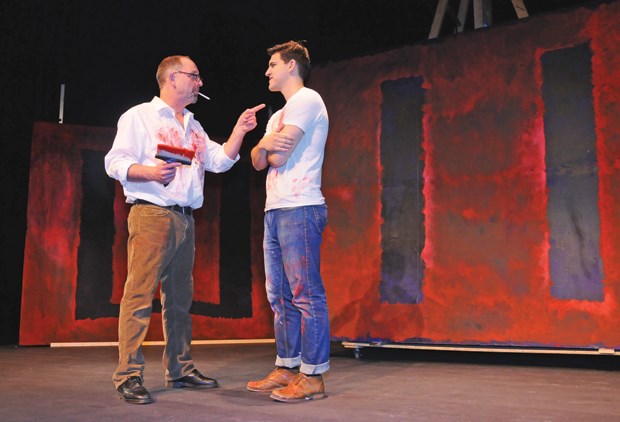First Impressions Theatre presents Red, Feb. 25 to March 12 at the Deep Cove Shaw Theatre, 4360 Gallant Ave., North Vancouver. Tickets: $18/$16 at firstimpressionstheatre. com or 604-929-9456.
In the years following the Second World War, the attention of the international art world was focused squarely on New York City where a new movement was taking hold.
Abstract expressionism had emerged as a fresh and unconventional genre. Today, the movement is perhaps most associated with Jackson Pollock and his signature splatter paintings, but there was a whole generation of American artists, such as Willem de Kooning, Franz Kline, Barnett Newman, Robert Motherwell and Adolph Gottlieb, creating large-scale works characterized by spontaneity and non-traditional techniques.
Among this circle of artists, also known as the New York School, was Mark Rothko. Born Marcus Rothkowitz in Dvinsk, Russia (now Latvia) in 1903, he immigrated to the U.S. with his family in 1913. Rothko is best known for his massive colour-field paintings, which feature stacked rectangles of colour, often in shades of red and black.
In the late 1950s, Rothko received a major commission to create a series of murals that would decorate the highend Four Seasons restaurant located in the brand new Seagram Building on Park Avenue in Manhattan.
The two years he spent working on this project, and his contentious eleventhhour decision to ultimately withdraw his murals and return his cash advance after deeming the Four Seasons an inappropriate place to display his work, is dramatized in the 2009 play Red by John Logan.
Local actor Cameron McDonald will disguise his Aussie accent to play the renowned American artist when First Impressions Theatre presents Red at the Deep Cove Shaw Theatre.
"I've had to do a lot of research on the guy, so it's been pretty exhaustive because the more I read about him, the more I feel I don't know him. There's just so much to the character," McDonald says. "He comes across as a narcissistic bully, but the more I read about him from his children he was a very kind, gregarious, sweet man."
Directed by Jim Hebb, the play is a two-hander featuring McDonald as Rothko and Mike Bodzanowski as Rothko's fictional assistant Ken. The thought of being in the spotlight for the full 90-minute, one-act play was initially a bit daunting, McDonald admits.
"When I first looked at (the script) I was very intimidated because it's 70-odd pages of me talking," he says.
But the rich dialogue carries itself, he notes, and he and Bodzanowski aren't alone on stage. There's a third and very important character: the art. Adding an element of unpredictability to the show, the actors will be stretching, priming and painting large canvases while juggling their lines. "Anything can happen," McDonald says.
Red follows Rothko and his assistant as they feverishly work on the Seagram commission inside a rented studio in the Bowery neighbourhood of New York. What starts as an odd pairing (Rothko is deeply passionate, intellectual and temperamental, while Ken is youthful, nervous and questioning) grows into a mutually respectful friendship.
McDonald suspects the two get off to a rocky start because Ken represents a new generation of pop artists that is taking over from the abstract expressionists, just as Rothko and his contemporaries took over from the cubists and surrealists of previous decades.
"I think what (Ken) represents for me is the new age that (Rothko) was rallying against - the popular art, the Andy Warhols, the Roy Lichtensteins - all those guys who were coming up with comic books and soup cans and, as he called it, zeitgeist art," says McDonald.
As the two characters converse and debate, questions are raised about art, commercialism and success.
"(Rothko) wanted the paintings to move people and unfortunately, to this day, a lot of people see them as blocks of red colour and black," McDonald says. "Red (is) the story behind what his intention was and the passion he had for painting and illuminating the canvas just from within through colour."
Although Logan's play is a fictional account of the Seagram commission, his script incorporates real quotes from Rothko that demonstrate how conflicted the artist was about hanging his work in a posh restaurant. "I know that place is where the richest bastards in New York will come to feed and show off and I hope to ruin the appetite of every son-of-a-bitch who eats there," McDonald recites.
Rothko suffered an aneurysm in 1968 and struggled with depression. He committed suicide in his studio in 1970 at the age of 66. For years, he kept his Seagram Murals, as they are now called, in storage, but the series was eventually dispersed and is now housed in three separate galleries: London's Tate Modern, Japan's Kawamura Memorial Museum and the National Gallery of Art in Washington, D.C. McDonald, who knew next to nothing about Rothko when he first took on the role, says he's developed a new enthusiasm for 20th century art history.
"I'm really interested in going back and tracing the roots of a lot of this stuff," he says, adding that he hopes the play has the same effect on audience members, particularly those who may not be familiar with Rothko and his work.
"I'm just hoping that people take notice of him now and identify another tragic passing of an artist."



